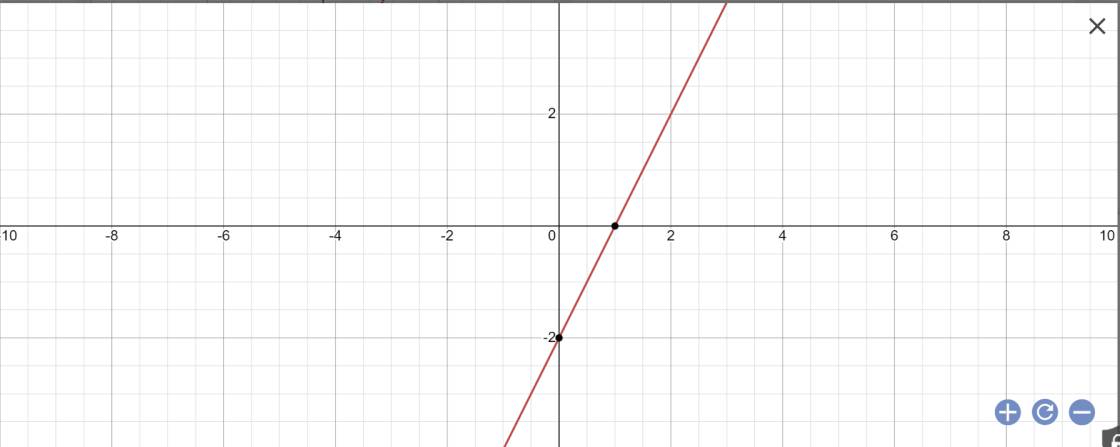Hãy nhập câu hỏi của bạn vào đây, nếu là tài khoản VIP, bạn sẽ được ưu tiên trả lời.

\(a,\Leftrightarrow x=0;y=0\Leftrightarrow3-m=0\Leftrightarrow m=3\\ b,\text{PT hoành độ giao điểm: }3mx-x+3-m=2x-3\\ \text{Thay }x=2\Leftrightarrow6m-m+1=1\Leftrightarrow m=0\\ c,y=4;x=0\Leftrightarrow3-m=4\Leftrightarrow m=-1\\ d,2y-x=5\Leftrightarrow y=\dfrac{1}{2}x+\dfrac{5}{2}\\ \left(d\right):y=x\left(2m-1\right)+3-m\text{//}y=\dfrac{1}{2}x+\dfrac{5}{2}\\ \Leftrightarrow\left\{{}\begin{matrix}2m-1=\dfrac{1}{2}\\3-m\ne\dfrac{5}{2}\end{matrix}\right.\Leftrightarrow\left\{{}\begin{matrix}m=\dfrac{3}{4}\\m\ne\dfrac{1}{2}\end{matrix}\right.\Leftrightarrow m=\dfrac{3}{4}\)
\(f,\Leftrightarrow2m-1>0\Leftrightarrow m>\dfrac{1}{2}\\ g,\Leftrightarrow2m-1< 0\Leftrightarrow m< \dfrac{1}{2}\)

a: Để hàm số đồng biến thì m-3>0
=>m>3
b: Vì (d) đi qua O(0;0) và B(-1;2) nên ta có hệ:
0(m-3)+n=0 và -(m-3)+n=2
=>n=0 và m-3=-2
=>m=1 và n=0
c: Vì (d)//y=x-2 nên m-3=1
=>m=4
=>(d): y=x+n
Thay x=0 và y=5 vào (d), ta được:
n+0=5
=>n=5
=>(d): y=x+5
d: Vì (d) đi qua A(2;1) và B(3;0) nên ta có hệ:
2(m-3)+n=1 và 3(m-3)+n=0
=>2m-6+n=1 và 3m-9+n=0
=>2m+n=7 và 3m+n=9
=>m=2 và n=3

\(a,\Leftrightarrow A\left(0;0\right)\in\left(d\right)\Leftrightarrow-2m+1=0\Leftrightarrow m=\dfrac{1}{2}\\ b,\Leftrightarrow x=3;y=4\Leftrightarrow3\left(m+1\right)-2m+1=4\\ \Leftrightarrow3m+3-2m+1=4\\ \Leftrightarrow m=0\Leftrightarrow\left(d\right):y=x+1\\ c,\text{PT hoành độ giao điểm: }x+1=-2x+4\Leftrightarrow x=1\Leftrightarrow y=2\Leftrightarrow B\left(1;2\right)\\ \text{Vậy }B\left(1;2\right)\text{ là giao 2 đths}\)

a: 
b: Để (d)//(d') thì \(\left\{{}\begin{matrix}m+1=2\\6< >-2\left(đúng\right)\end{matrix}\right.\)
=>m+1=2
=>m=1
c:
(d'): y=(m+1)x+6
=>(m+1)x-y+6=0
Khoảng cách từ O đến (d') là:
\(d\left(O;\left(d'\right)\right)=\dfrac{\left|0\cdot\left(m+1\right)+0\cdot\left(-1\right)+6\right|}{\sqrt{\left(m+1\right)^2+\left(-1\right)^2}}\)
\(=\dfrac{6}{\sqrt{\left(m+1\right)^2+1}}\)
Để \(d\left(O;\left(d'\right)\right)=3\sqrt{2}\) thì \(\dfrac{6}{\sqrt{\left(m+1\right)^2+1}}=3\sqrt{2}\)
=>\(\sqrt{\left(m+1\right)^2+1}=\sqrt{2}\)
=>\(\left(m+1\right)^2+1=2\)
=>\(\left(m+1\right)^2=1\)
=>\(\left[{}\begin{matrix}m+1=1\\m+1=-1\end{matrix}\right.\Leftrightarrow\left[{}\begin{matrix}m=0\\m=-2\end{matrix}\right.\)